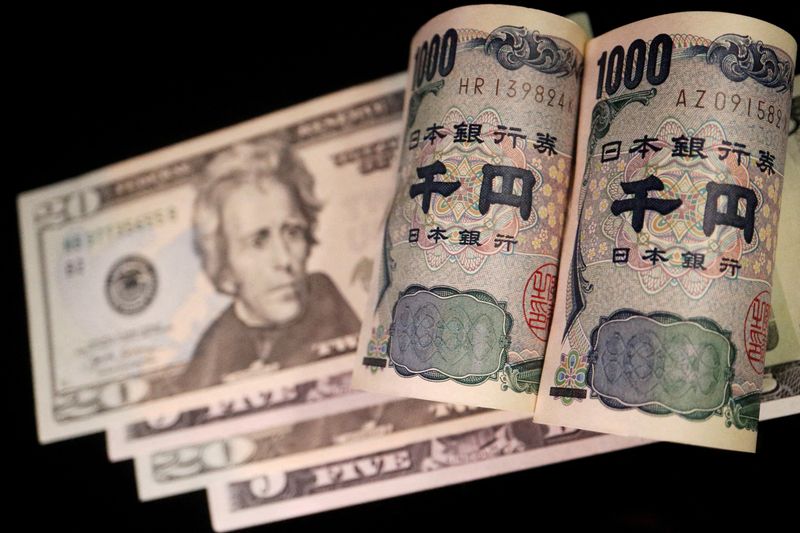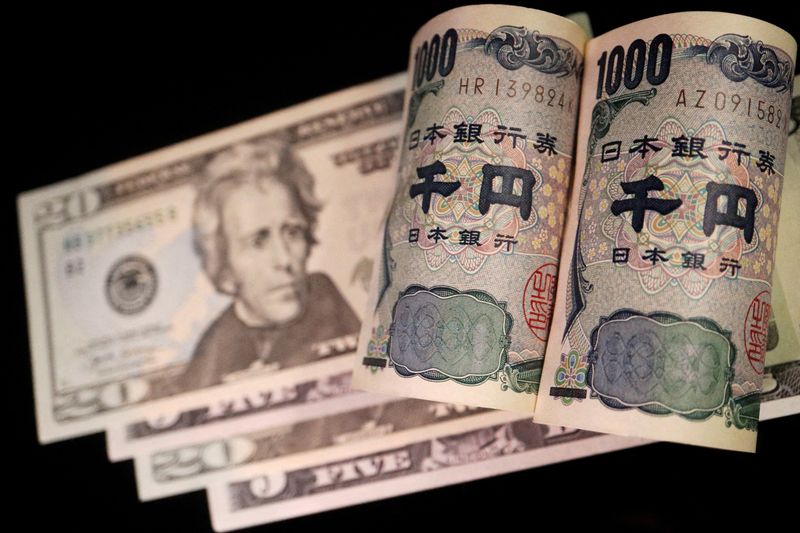Forex
Dollar stalls as dovish Fed and China hopes help euro


© Reuters. FILE PHOTO: Banknotes of Japanese yen and U.S. dollar are seen in this illustration picture taken September 23, 2022. REUTERS/Florence Lo/Illustration/File Photo
By Harry Robertson and Tom Westbrook
LONDON/SINGAPORE (Reuters) – The dollar stalled and the euro ticked up on Tuesday as investors reacted to a sharp drop in U.S. bond yields on the back of dovish Federal Reserve comments, as well as the prospect of stimulus from China.
Moves were relatively muted as traders waited for more Fed officials to speak later in the day, as well as minutes from the last Fed meeting to be released on Wednesday and U.S. inflation data on Thursday. Investors were also keeping a close eye on the conflict between Israel and the Palestinian Islamist group Hamas.
The euro was last up 0.12% against the dollar at $1.0581. Bloomberg reported that China is weighing the issuance of at least 1 trillion yuan ($137.1 billion) of additional sovereign debt for spending to boost its struggling economy, which analysts said helped currencies such as the euro which are seen as more exposed to global growth.
The , which tracks the greenback against six peers, was last up less than 0.1% at 106.05. It remained below last week’s 11-month high of 107.34 and traded at roughly the same position as a week earlier.
U.S. bond yields dropped sharply on Tuesday when trading reopened following the Columbus Day holiday. The fall in global borrowing costs helped boost Asian and European stocks.
“With Treasury yields significantly dropping this morning during cash trading and that translating into a more constructive session for European equities, it seems as if FX traders are more comfortable in rotating out of the dollar,” said Simon Harvey, head of FX analysis at Monex Europe.
“This has likely been supported by news that China is set to increase its fiscal spending, although we think this is merely improving sentiment at the moment as the details are fairly opaque.”
The yen was last lower, with the dollar up 0.38% at 149.06 yen. Japan’s currency bounced after the Kyodo news agency reported that the Bank of Japan is considering raising its forecast for core consumer inflation this year, but then gave up its gains.
Analysts said the drop in U.S. yields was driven by comments from two Fed officials on Monday saying that rises in long-term yields might negate the need for further hikes, and by traders seeking out safe-haven assets after Palestinian militant group Hamas’ assault on Israel.
The yield on the 10-year U.S. Treasury, which moves inversely to the price, was last down 7 basis points at 4.709%. It hit its highest since 2007 last week at 4.887%.
Israel’s shekel was pinned at 3.95 to the dollar, just off an almost eight-year low hit on Monday, after the central bank pledged $30 billion to stem the sell-off in the currency.
“They’re firmly engaged here and I think they want to stop it from trading at that 4 level,” said Chris Turner, head of markets at ING.
Israeli officials said on Tuesday that Israel had re-established control over the Gaza border as it pounded the enclave with airstrikes.
The Swiss franc, a traditional safe-haven currency, was last flat, with the dollar trading at 0.9068 francs. Britain’s pound was up 0.1% at $1.2244.
Fed officials Raphael Bostic, Christopher Waller, Neel Kashkari and Mary Daly are due to speak later on Tuesday.

 Forex3 years ago
Forex3 years agoForex Today: the dollar is gaining strength amid gloomy sentiment at the start of the Fed’s week

 Forex3 years ago
Forex3 years agoUnbiased review of Pocket Option broker

 Forex3 years ago
Forex3 years agoDollar to pound sterling exchange rate today: Pound plummeted to its lowest since 1985

 Forex3 years ago
Forex3 years agoHow is the Australian dollar doing today?

 Cryptocurrency3 years ago
Cryptocurrency3 years agoWhat happened in the crypto market – current events today

 World3 years ago
World3 years agoWhy are modern video games an art form?

 Commodities3 years ago
Commodities3 years agoCopper continues to fall in price on expectations of lower demand in China

 Economy3 years ago
Economy3 years agoCrude oil tankers double in price due to EU anti-Russian sanctions





















